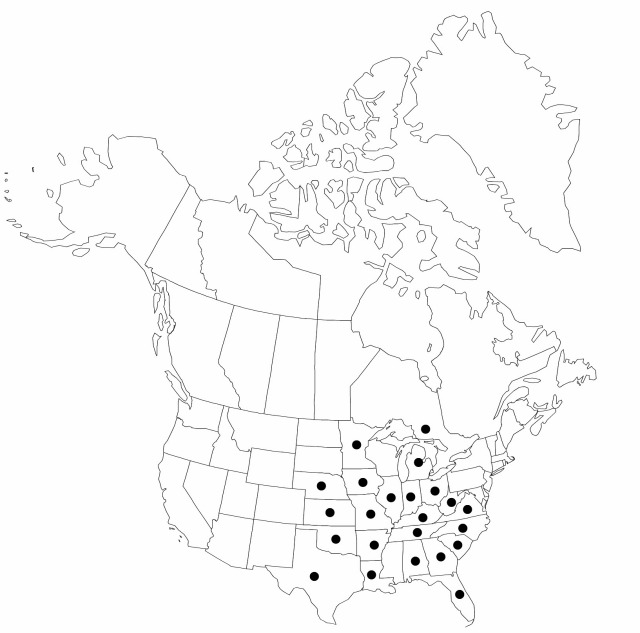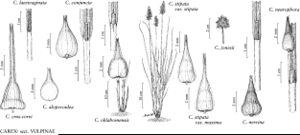Carex crus-corvi
in G. Kunze, Suppl. Riedgräs., 128. 1842.
Plants with basal sheaths of previous year persistent, entire. Culms to 90 cm × 5 mm, scabrous. Leaves: sheaths all with blades, fronts smooth, red spotted, indistinctly linearly veined, apex redbrown, membranous, truncate, minutely ciliate; ligules rounded, 2 mm, free limb to 0.5 mm; blades glaucous, not epistomic, to 90 cm × 12 mm. Inflorescences densely spicate, cylindric, elongate, with 15–25 distinguishable branches, 10–20 × 6 cm; proximal internode to 10 mm; proximal bracts setaceous, apparent. Scales hyaline. Perigynia pale-brown, redbrown distally, 10–12-veined abaxially, 5-veined adaxially, to 8 mm, body to 1.2 mm wide, base to 2.2 mm wide, base distended proximally forming disk, cordate; stipe to 0.9 mm; beak to 4.5 mm, mouth deeper abaxially, serrulate, apical teeth somewhat spreading. Achenes ovate, 2.5 × 1.4 mm; stalk to 0.2 mm; persistent style base cylindric, 0.3 mm. 2n = 52.
Phenology: Fruiting May–Aug.
Habitat: Seasonally saturated or inundated soils in wet meadows, marshes, swamps, alluvial bottomlands
Elevation: 0–1000 m
Distribution

Ont., Ala., Ark., Fla., Ga., Ill., Ind., Iowa, Kans., Ky., La., Mich., Minn., Mo., Nebr., N.C., Okla., Ohio, S.C., Tenn., Tex., Va., W.Va.
Discussion
Primarily a species of the Mississippi drainage, Carex crus-corvi also occurs along the coastal plain.
Selected References
None.
Lower Taxa
"shortened" is not a number."widest" is not a number.
